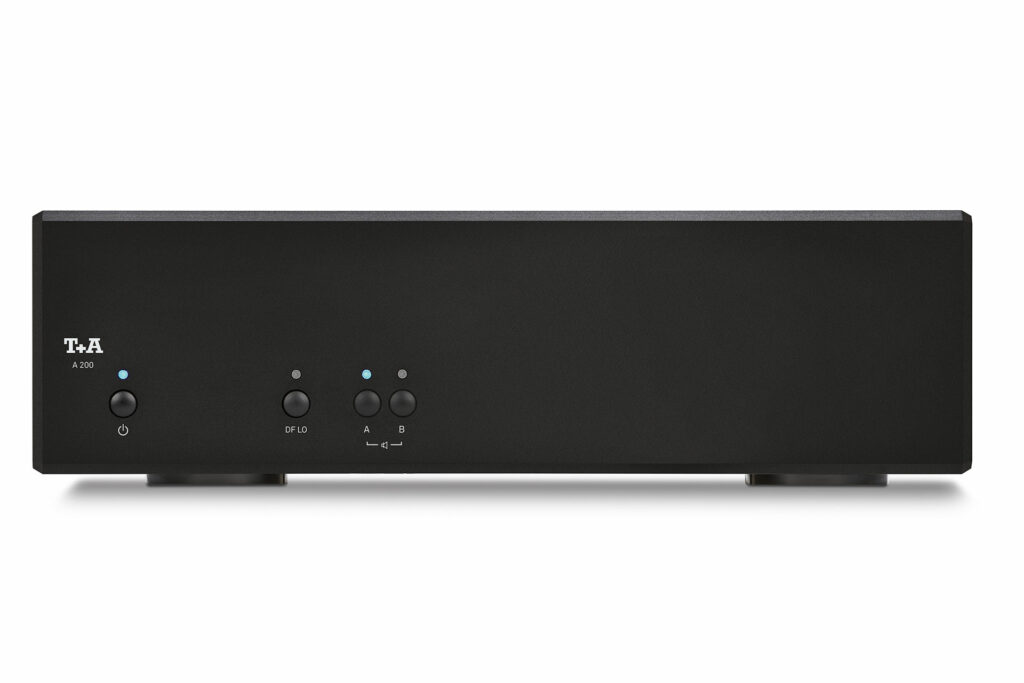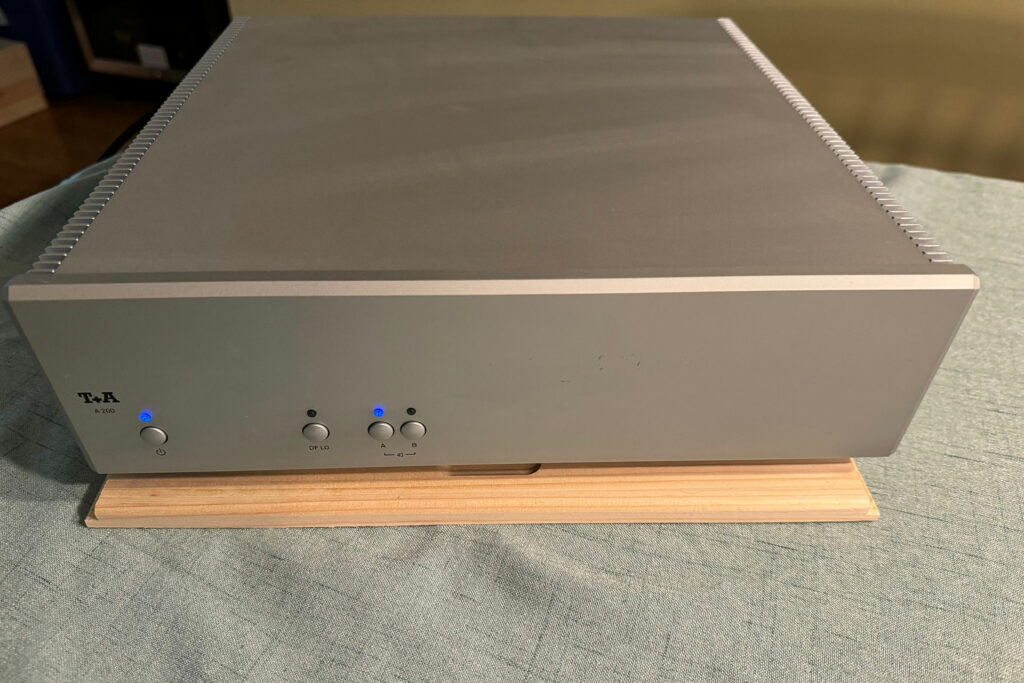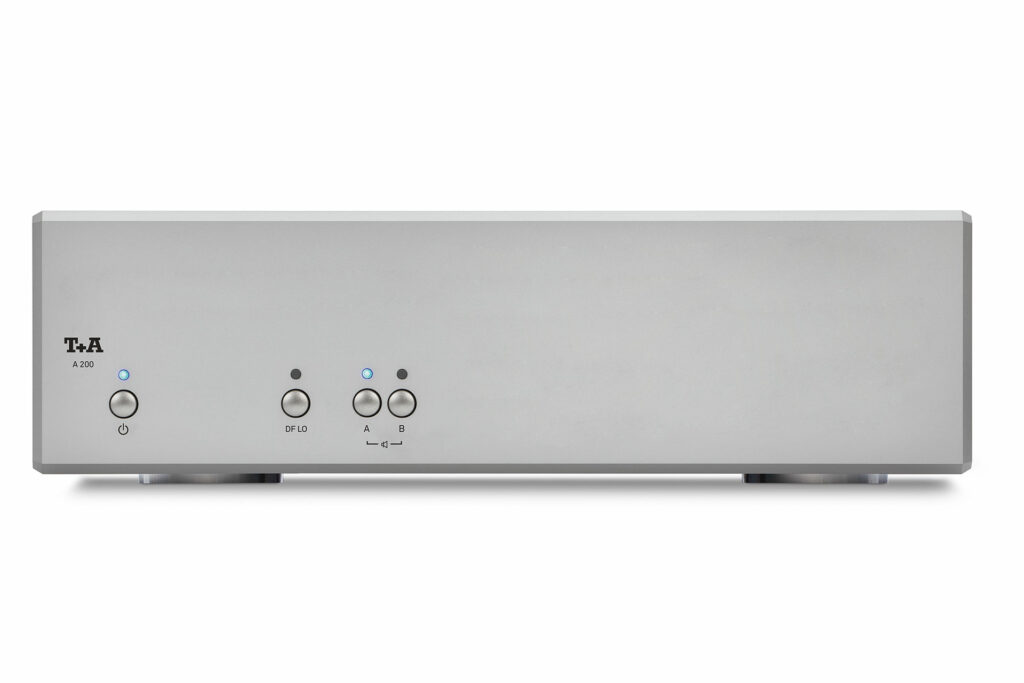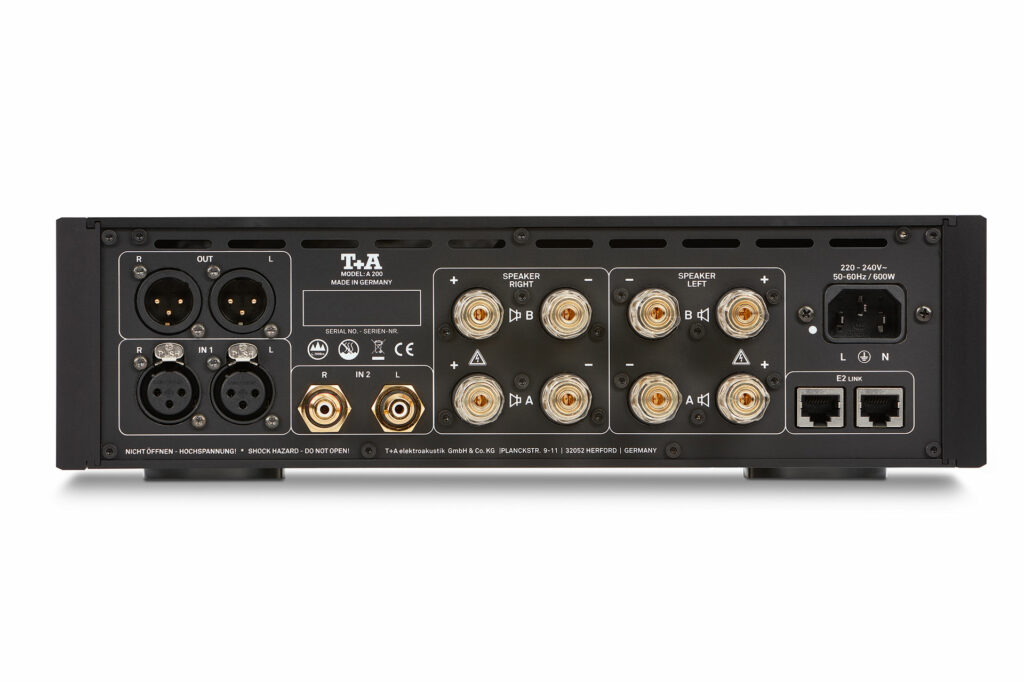This is the last in a series of T+A reviews in which we already looked at their MP 200 music player and DAC 200 Preamplifier/DAC (read my reviews). The A 200 Amplifier we discuss below may be the most flexible in that, while it is designed to complement the 200 series, it can easily be integrated into other systems without any loss of functionality other than power trigger.
The T+A A 200 is a Class-D amplifier; this may knock it out of the running for some audiophile purists, but would I caution them not to make such a rash decision. Not all amplifiers, Class-D or otherwise, are created equal. As with the other components we have recently reviewed, the A 200 has benefitted from the technology in T+A’s HV flagship line. We will get into those technical details later, after reviewing the basics. Despite the “200” in its name, the A 200 is a 250-watt-per-channel amplifier into four ohms. If more power is needed, T+A makes a mono version with 420 watts or, if you’ve already invested one A 200, the balanced outputs making bi-amping easy to accomplish.

The 200 series is visually distinct, with its compact chassis and silver or black metal casework that makes it readily identifiable as a T+A product. The 200 series chassis measures 12.6 inches wide by 13.4 inches deep and four inches high. The A 200 weighs 11 pounds and feels very solid, as do the other components in the lineup. The industrial design of the 200 series carries over design elements from other T+A lines, including matte finishes, beveled edges, and control knobs with a distinctive flange design. As with the other 200 series components, there is a clever control system and a control cable that connects the components, which permits the units to function as one component controlled by T+A’s own app, which works on both iOS and Android devices. Its functionality on the A 200 appears to be limited to triggering power, which is of limited functionality, as the A 200 has an automatic power function that powers up the unit from standby mode upon detecting a music signal at the inputs.

What Makes the T+A A 200 Power Amplifier Special?
- The T+A A 200 amplifier builds upon the proven PURIFI Eigentakt Class-D output stages, while adding in proprietary T+A technology. Why re-create the wheel if you do not need to? FutureAudiophile.com reviewers have raved about the Eigentakt technology in other amplifiers. T+A takes the Eigentakt modules, already known for being stable, regardless of loudspeaker loads and their proprietary power supply technology, to maximize performance.
- The voltage amplification section is derived from T+A’s flagship HV Series. The “HV” in the flagship HV Series not surprisingly stands for High Voltage. The HV circuit utilizes high-operating voltage, said to result from the overall circuit design. and provides particularly linear reproduction of audio signals, while eliminating harsh feedback. What this means to the user is that minute details and dynamic scales will be accurately and dynamically reproduced.
- You get a high-frequency power supply. If you hang out at audio shows or peruse audiophile forums, you might see some criticism of switching power supplies. Some of this is justified. T+A, again, does something slightly different with the power supply to maintain the beneficial efficiency without the detrimental interference. In this case the T+A developed a high-frequency power supply with a pure sine wave output. High-speed capacitors capable of recharging 100,000 times a second are said to act as a filter for residual traces of interference.
- Intelligent Safe Control is T+A’s control system, which operates to keep the amplifier functioning within its normal parameters, which is a sort of technological insurance policy that is intended to prevent you from ever damaging your amp during use.
- As with the rest of the T+A 200 Series, the fit and finish of the Amp 200 is understated and well-executed. The 200 series products from T+A are about two-thirds of normal component width, which makes me suspect they will not be hidden away in a rack, but rather someplace more visible The Amp 200 has an understated front panel. Available in matte black or silver, the front panel has four small buttons, each with an LED to show the power status, damping factor selection and A/B speaker switch.
- I have reviewed lots of amplifiers over the past 25 years or so, and this is the first that I can recall having adjustable damping. In high, the damping factor is said to be greater than 800 and in low, greater than 70. I suspect that most people will keep it on high, but there is a change in sound, and it varies depending on the speakers being used.
Why Should You Care About the T+A A 200?
This is the product of the Series 200 pieces that I think will have the broadest appeal to audiophiles. The A 200 is powerful, compact, runs cool and sounds really good. Having a complete Series 200 stack provides for integrated control between the components, which makes for seamless integration. However, as the amplifier’s only control is power, and there is an auto-sensing circuit to control power, the A 200 should work equally well with any system. I tried it with a couple of other pieces, and the auto-sensing system worked with them.

Some Things You Might Not Like About the T+A A 200
- The T+A A 200 not bridgeable. While a monoblock version is available, it would be nice to have the option to start with one A 200 and, if more power is needed, bridge it and add a second bridged amplifier.
- The T+A A 200 does not have any trigger connections. I know the signal-sensing automatic power on/off circuit reduces the need for this, but sometimes I like to power on the system without any signal playing, so that it can warm up.
- Its compact form factor doesn’t physically match other more standardized, 17-inch-wide components. I know some people prefer the small size, but it may not fit in aesthetically with a stack of full-sized equipment.
Listening to the T+A A 200 Amplifier …
I set up the T+A A 200 with the DAC200 DAC/Preamplifier and MP200 Multi-Source Player, making for a complete Series 200 stack playing through Revel F328Be and Bowers & Wilkins 702 S3 Signature speakers. I used Kimber Kable for the digital connections and Wireworld for analog, including speaker connections. I switched the damping factor selection a few times, and preferred the Hi setting; all my listening was done in that mode. Lastly, only one set of speakers was connected at a time, using the “A” outputs, with the “B” outputs remaining unused.
I started with Gregory Porter’s “Holding On” (Tidal), a track that straddles the line between Blues and Jazz. The dynamics of the piano were realistic, as was Porter’s voice. The positions of the instruments were distinct on this smaller soundstage (recording, not age), and were locked in place providing a realistic portrayal. The notes from the double bass played by Aaron James were solid, clean and natural-sounding.
While discussing solid, low-frequency performance, I will use this as an opportunity to yet again include Taylor Swift, as she is three for three in my T+A reviews in terms of demo material. Us audiophile writers can indeed vary from our beloved audiophile standards. Swift’s “Vigilante Shit”(Tidal, 48 kHz/24-bit) had tight and solid synthesized bass notes. The A 200 retained tight control of both the Bowers & Wilkins and Revel speakers when playing this track. Unfortunately, this heavily-processed track does not lend itself to an evaluation of vocal or anything else natural.
Sticking with newer, really solid audiophile-grade recordings, I listened to Marcin’s rendition of “Kashmir,” as I have found Marcin to be in very heavy rotation at my house when my good system is cranking. Marcin’s guitar style is replete with slaps to the guitar body (think: percussive) and exquisite, often two-handed finger work (think: Eddie Van Halen, but on an acoustic guitar). The T+A A 200 does a very good job delivering the details of the recording, making for a realistic reproduction. The choice of recording space, a concrete parking garage, also plays a large role in the sound of this track, and the reverb of this space is readily apparent when listening through the A 200.
I finished off with Tchaikovsky’s “1812 Overture” performed by Cincinnati Symphony Orchestra led by Eric Kunzel (Telarc, CD), which is large in scale with many layers and, or course, the infamous cannons which can test a system’s dynamic capabilities. The T+A A 200 maintained control while peeling back layers of detail. I listened closely to the string and wind instruments, which were rendered with clarity, and distinctly placed on a wide soundstage extending well beyond the outer edges of both speaker systems. It was with this recording that I switched back and forth again between the Hi and Lo damping. I found the Lo setting had a less well-formed soundstage, with the strings losing some of their distinction and blending in together. The T+A A 200 did a formidable job rendering dynamic impact while maintaining control, regardless of level.
Will the T+A A 200 Amplifier Hold Its Value?
Yes. Amplifiers tend to last longer without becoming outdated. While there may be new Class-D (or other) circuits that provide more efficiency or claim better sound quality, the A 200 will continue to perform at the same level. With material and labor costs rising, it is unlikely that a similarly-performing product with the same build quality, fit and finish will be made in the future at a significantly lower price point so as to make a noticeable impact in the A200’s resale value. Further, it does not appear that there are any proprietary parts that would not be able to be obtained in the future to service the A 200.

What Is the Competition for the T+A A 200?
The relatively new Amped America AMP 2400 Class-D amplifier (read the review) utilizes the Pascal amplification circuit to create 400 watts per channel. It costs slightly less than the T+A at $5000, and I understand that the people behind this company are the same as those bringing back Adcom, a value-oriented brand popular form my early audiophile days. AGD Productions’ Tempo di GaN amplifier is similarly priced at $5,500 and, like the T+A, features a small form factor. The similarities continue inside, where there is a high-speed switching supply like that of the T+A. Lastly, the Benchmark Media Systems AHB2 ($3,499) is a Class-AB amplifier that utilizes THX AAA circuitry to produce 100 watts per channel. If you need more power, it is bridgeable to 380 watts into eight ohms, or 480 Watts into six ohms.

Final Thoughts on the T+A A 200 Power Amplifier …
The T+A A 200 is likely to be the most long-lasting, relevant and flexible component in the Series 200 series over time. The A 200 will not be behind the curve when/if an exciting new file format comes out. The T+A A 200 is not subject to app control or other concepts that may or may not be in style a decade or two from now. What the T+A A200 does is deliver excellent sound quality through a variety of speakers, while not taking up much space or wasting energy. The sound of the A200 was well-controlled, solid, with a wide soundstage, and remained so with different speakers. This spoke a lot about the stability of the amplifier to drive different speakers without changing its own sonic signature. While the A 200 is not inexpensive, it performs above what its price would suggest, and does so with ease, little heat, from a small form factor, and with style.



